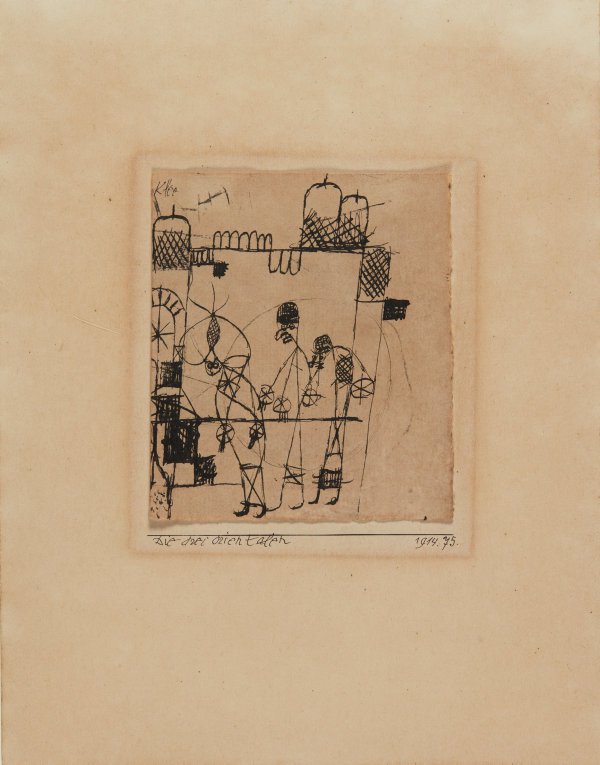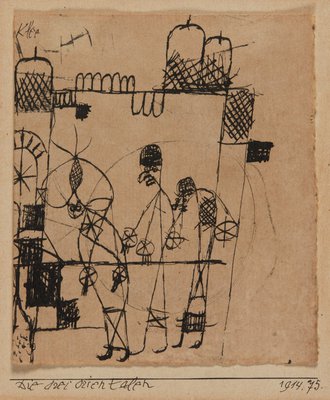-
Details
- Alternative title
- Die drei Orientalen
- Date
- 1914
- Media category
- Drawing
- Materials used
- pen and black ink on brown paper, adhered to the artist's original mount
- Dimensions
- 10.5 x 9.2 cm sheet; 23.5 x 18.3 cm board
- Signature & date
Signed u.l., pen and black ink "Klee". Dated on mount l.r., pen and black ink "1914...".
- Credit
- Gift of Jocelyn Plate in honour of Carl Plate 2018. Donated through the Australian Government's Cultural Gifts Program
- Location
- Not on display
- Accession number
- 293.2018
- Copyright
- Artist information
-
Paul Klee
Works in the collection
- Share
-
-
About
From 1911 to his death, Klee unfailingly recorded his production in a handwritten catalogue in meticulous detail, including their numberings and titles. The present drawing bears his own title 'Die drei Orientalen', Klee’s oeuvre’s catalogue number 1914.75 and, like most works executed on paper, was glued onto cardboard by the artist.
In April 1914, Paul Klee visited Tunisia, accompanied by his artist friends Louis Moilliet and August Macke. This brief fortnight’s stay in North Africa triggered one of the Swiss artist’s most fruitful creative periods, regarded to this day as a turning point in his career. Recording the journey in detail in his diaries, Klee hailed it as his ‘breakthrough to colour’. In Tunisia, he limited himself to watercolour and drawing and executed respectively 30 and 13 in each medium.
Klee likely drew the scene of 'The three Orientals' in front of the motif, integrating for instance the motif of the domes – symbol of the oriental city. However, the pen and ink drawing reveals early signs of his experiments, turning the structure of the drawing into a constructive, graphic vocabulary of lines – which he used as the boundaries for colour fields later in his watercolours and paintings – particularly visible here in the body profile of the three figures and the architectural features behind: “Went to work at once and painted in watercolour in the Arabic quarter. Began the synthesis of urban architecture and pictorial architecture”.
'Die drei Orientalen' is a rare example among Klee’s Tunisian works that shows human figures. When figures do appear, they are invariably minor accessories, “ciphers of a crowd’, according to art historian Otto Karl Werckmeister. The drawing also reveals Klee’s childlike, poetic vision in transforming an observed scene into a cartoonish vignette redolent of the Three Magi, a classic subject in Christian art through the centuries.
Carl Plate travelled extensively in Europe between 1936 and 1940, visiting Paris, several Scandinavian countries, the Soviet Union and London. Returning to Sydney in July 1940, he had acquired an appreciation of international modernism and a cosmopolitan outlook on life and art and established himself as an artist and advocate for modern art, notably through the activities of his newly-established Notanda Gallery. Purchased in Paris or London before Plate returned to Sydney, the drawing first appeared in an exhibition of French and continental works at the Notanda Gallery in February 1941. According to Cassi Plate, the artist’s daughter, Klee was a major inspiration and favourite artist of Plate. It is interesting to note that when exhibited in 1941, the drawing was the only work which was not for sale. -
Exhibition history
Shown in 5 exhibitions
Paul Klee, Fritz Schaefler, Th C Pilartz, Zinglers Kabinett für Kunst- und Bücherfreunde, Frankfurt am Main, May 1919–May 1919
Paul Klee, Johannes Molzahn, Fritz Stuckenberg, Kunstverein Jena, Jena, 04 Jan 1920–01 Feb 1920
Kleine Paul Klee Ausstellung, Graphisches Kabinett J B Neumann, Berlin, Mar 1921–Apr 1921
Exhibition of modern French and continental pictures, Notanda Gallery, Sydney, 23 Feb 1941–15 Mar 1941
Art without epoch: an exhibition of overseas loan works exhibited by the Contemporary Art Society of NSW, Contemporary Art Society (New South Wales), , 22 Apr 1950–10 May 1950
-
Bibliography
Referenced in 10 publications
-
Margareta Benz-Zauner, Werkanalytische Untersuchungen zu den Tunesien-Aquarellen Paul Klees, Frankfurt am Main, 1984, p 8.
-
Anna Maria Ehrmann-Schindlbeck, Paul Klee in Jena 1924, Jena, 1999, p 122.
-
Christoph Otterbeck, Europa verlassen: Künstlerreisen am Beginn des 20. Jahrhunderts, Cologne, 2007, p 167.
-
The Paul Klee Foundation, Museum of Fine Arts, Berne (Editor), Paul Klee catalogue raisonné, volume 2, 1913–1918, London, 2000, p 164, no 1175. not illustrated.
-
Paul Klee, Johannes Molzahn, Fritz Stuckenberg, Jena, 1920, np, no 7. as 'Drei Orientalen. Feder 1914.
-
Zingler's Kabinett für Kunst- und Bücherfreunde Frankfurt a. M. Kaiserstrasse 23. Katalog zur Eröffnung der Galerie. Erste Ausstellung Paul Klee, Fritz Schaefler, Th. C. Pilartz, Frankfurt am Main, 1919, p 21, no 18. as 'Drei Orientalen. Feder 1914. M135'.
-
Kleine Paul Klee Ausstellung, Berlin, 1921, p [1], no 25. as 'Die drei Orientalen' 1914.
-
Exhibition of modern French and continental pictures, Sydney, 1941, p [2], no 7. as ‘Old men of the East’, pen drawing, not for sale.
-
Art without epoch: an exhibition of overseas loan works exhibited by the Contemporary Art Society of NSW, Sydney, 1950, p [2], no 55. as 'Old Men of the East', lent by C. O. Plate, Esq.
-
Frankfurter Kunstmesse.Messamt Frankfurt.M, Frankfurt am Main, 1920, p 253, no 963 (9 Oct 1920). as 'Die drei Orientalen' 1914m Federzeichnung (sign) (10 1/2 X 9 1/2).
-


